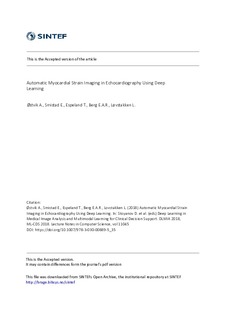Automatic Myocardial Strain Imaging in Echocardiography Using Deep Learning
Journal article, Peer reviewed
Accepted version
Permanent lenke
http://hdl.handle.net/11250/2577745Utgivelsesdato
2018Metadata
Vis full innførselSamlinger
- Publikasjoner fra CRIStin - SINTEF AS [5801]
- SINTEF Digital [2501]
Originalversjon
Lecture Notes in Computer Science. 2018, 11045 309-316. 10.1007/978-3-030-00889-5_35Sammendrag
Recent studies in the field of deep learning suggest that motion estimation can be treated as a learnable problem. In this paper we propose a pipeline for functional imaging in echocardiography consisting of four central components, (i) classification of cardiac view, (ii) semantic partitioning of the left ventricle (LV) myocardium, (iii) regional motion estimates and (iv) fusion of measurements. A U-Net type of convolutional neural network (CNN) was developed to classify muscle tissue, and partitioned into a semantic measurement kernel based on LV length and ventricular orientation. Dense tissue motion was predicted using stacked U-Net architectures with image warping of intermediate flow, designed to tackle variable displacements. Training was performed on a mixture of real and synthetic data. The resulting segmentation and motion estimates was fused in a Kalman filter and used as basis for measuring global longitudinal strain. For reference, 2D ultrasound images from 21 subjects were acquired using a GE Vivid system. Data was analyzed by two specialists using a semi-automatic tool for longitudinal function estimates in a commercial system, and further compared to output of the proposed method. Qualitative assessment showed comparable deformation trends as the clinical analysis software. The average deviation for the global longitudinal strain was (−0.6±1.6 −0.6±1.6 )% for apical four-chamber view. The system was implemented with Tensorflow, and working in an end-to-end fashion without any ad-hoc tuning. Using a modern graphics processing unit, the average inference time is estimated to (115±3 115±3 ) ms per frame.
